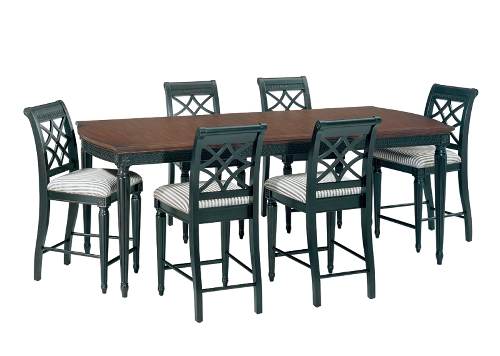Mix it up when decorating
"Match sets of anything are doubtless the work of those who have but little taste. Tis better to have dissimilarity." Kenko, also known as Yoshida Kenko (1283-1350), Japanese author and Buddhist monk.
This quote caught my attention when I was thumbing through the book "Wabi Sabi Style," by James and Sandra Crowley (Gibbs Smith, 2001). After that intro, the Crowleys went on to say, "Early in the fourteenth century Kenko wrote these inspired words -- words that are still accurate today as they were seven hundred years ago. The idea that matched sets are unattractive stems from the lack of imagination and serendipity involved in their creation or assemblage. Matched sets, like perfect symmetry, are the expected."
Wow -- I couldn't have said it better and am in total agreement. Even though this is a little harsh, in reality, rooms that are "unmatched" have so much more personality. They also look like they have evolved, and didn't come in a box.
Furniture retailers discovered many years ago that most shoppers didn't have a clear idea of how to lay out a room or exactly what pieces would look good together. So, they began putting together little vignettes, simulating a living, dining or bedroom scenario, complete with rugs, lamps, florals and other accessories. The hope was that the shopper would be wowed by what they saw and just buy the whole thing. And they did. Consequently, a lot of rooms are perfectly matched, i.e., matching end tables or nightstands, matching lamps, side chairs or pieces all in the same wood finish or design.
Just as you hear people say they don't feel comfortable putting their outfits together and like it when they can go into a clothing store and see outfits already matched up, shoppers have fallen into that same routine by buying a roomful of furniture prestaged by the store.
The most attractive and interesting rooms to me are not filled with matched sets. Even if you are more comfortable with matching finishes, i.e., woods and metals, you can still get a good mix in your room if you use different end tables or nightstands, or even different chairs for your dining room table.
In your bedroom, try a round table for one side of the bed and a small chest for the other. If you use wooden pieces for your night tables, throw in a painted bureau or armoire to mix it up. Small mirrored chests make wonderful nightstands and would look great with a wooden dresser or chest.
Dining rooms offer great opportunity to mix and match also. The easiest route is to mix up your chairs. Furniture stores even offer up those options with different end chairs. By the way, none of the chairs have to match the table either.
Living rooms just cry out for mixing and matching. It's a great place to try mixing up your upholstery and case goods. After purchasing your anchor piece, which is usually a sofa, there are tons of options to give your room personality: unmatched side tables, an ottoman or upholstered bench for a coffee table, different lamps on your tables or diverse styles and upholstery on your chairs. To add to the mix, it's always fun to add in the unexpected -- an antique desk, painted or ethnic chest or a garden seat to hold stacked books or to pull up for extra seating.
Using any of these ideas will give your spaces more interest and, quite frankly, much more personality. Look-alike rooms can be boring and even if you picked out the matched set, chances are you will tire of it much more quickly than if the room had more diversity. Buying the basics and then adding pieces along the way will keep your interest and make you appreciate your "things" more.
So, don't take Kenko's words personally, just think about them the next time you shop for furniture. Don't let the stores make your decisions; use your "personality" to arrange your space and have your rooms look like they did evolve over time. Try mixing and matching -- it's great fun, and awesome.
Carolyn Muse Grant is a design consultant, expert home stager and creator of beautiful spaces. Questions can be sent to her at creativemuse@cox.net.


















